Google Cloud SQL Server is a fully-managed database service that helps you set up, maintain, manage, and administer your SQL Server relational databases on Google Cloud Platform.
You can ingest data from your Google Cloud SQL Server database using Hevo Pipelines and replicate it to a Destination of your choice.
Prerequisites
Perform the following steps to configure your Google Cloud SQL Server Source:
Enable Change Tracking
The Change Tracking mechanism captures changes made to a database. To enable change tracking, connect to your SQL Server database as a user with ALTER DATABASE privilege using any SQL client tool, such as sqlcmd, and enter the following commands:
Note: Replace the placeholder values in the commands below with your own. For example, <database_name> with demo.
-
Enable change tracking at the database level:
ALTER DATABASE <database_name> SET CHANGE_TRACKING = ON
(CHANGE_RETENTION = 3 DAYS, AUTO_CLEANUP = ON)
The CHANGE_RETENTION value specifies the duration for which change tracking information is retained. You can use AUTO_CLEANUP to enable or disable the cleanup task that removes old change tracking information. Read Enable Change Tracking for a Database.
Note: Hevo recommends that you set the CHANGE_RETENTION value to 3 DAYS. This reduces the risk of log expiry in the case of Pipelines having a low sync frequency. For example, 24 hours.
-
Enable change tracking for each table that you want to replicate:
ALTER TABLE <schema_name>.<table_name> ENABLE CHANGE_TRACKING
Repeat this step for each table you want to replicate using Change Tracking. Read Enable Change Tracking for a Table.
Note: If the Schema Evolution Policy for your Pipeline is set to Allow all changes and a new table is created in your schema after the Pipeline creation, you need to enable change tracking for the new table. After that, refresh the schema so that Hevo can begin ingesting data from it. If change tracking is not enabled, Hevo marks the object as inaccessible and does not ingest any data from it.
Allowlist Hevo IP addresses for your region
You need to allowlist the Hevo IP address for your region to enable Hevo to connect to your Google Cloud SQL Server database. To do this:
-
Log in to the Google Cloud SQL Console and click the Instance ID that you want to connect to Hevo.

-
In the left navigation pane, click Connections.
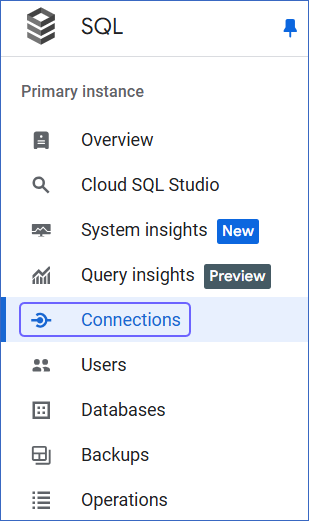
-
On the Connections page, click the NETWORKING tab, scroll down to the Authorized networks section, and then click ADD A NETWORK.
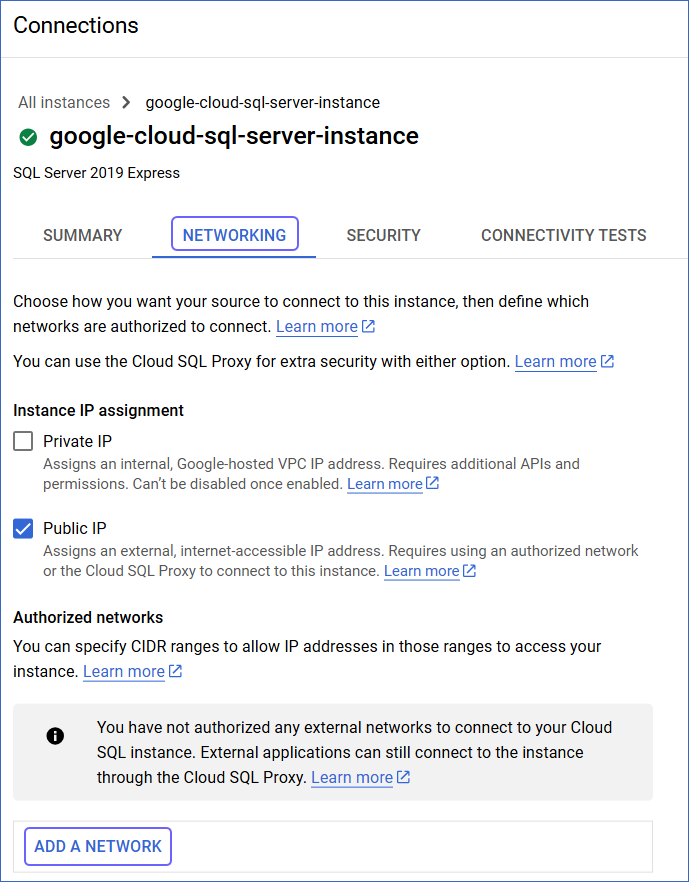
-
In the New network panel, specify the following:
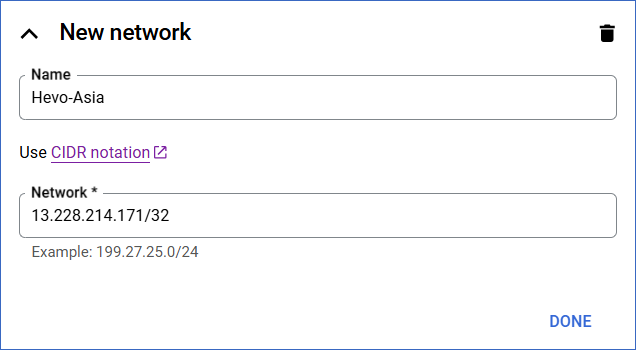
-
Click DONE.
-
(Optional) Click ADD A NETWORK and repeat steps 4 and 5 to add all the IP addresses you want to add.
-
Click SAVE.
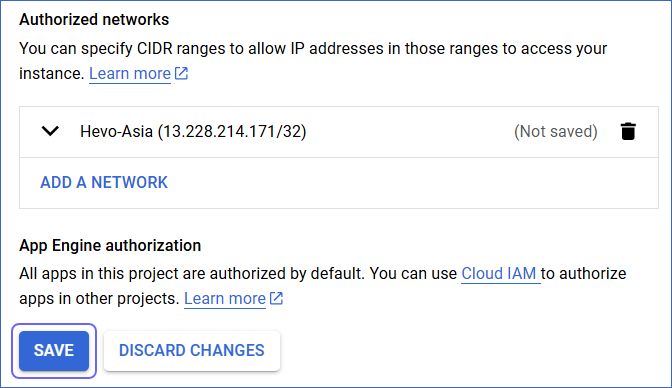
Create a Database User and Grant Privileges
1. Create a database user (Optional)
Note: Skip to the Grant privileges to the user section if you are using an existing database user.
Perform the following steps to create a database user in your Google Cloud SQL Server database:
-
Connect to your Google Cloud SQL Server database as a masteruser with any SQL client tool, such as sqlcmd.
-
Run the following commands:
-- Select a database
USE <database_name>;
-- Create a login and a database user
CREATE LOGIN <login_username> WITH PASSWORD = '<password>';
CREATE USER <database_username> FOR LOGIN <login_username>;
Note: Replace the placeholder values in the commands above with your own. For example, <login_username> with hevouser.
2. Grant privileges to the user
The database user for Hevo requires the following privileges to connect to and ingest data from your Google Cloud SQL Server database:
| Privilege |
Grants access to |
| SELECT |
Retrieve rows from the database tables. |
| VIEW CHANGE TRACKING |
View changes made to tables or schemas for which with the Change Tracking feature is enabled. |
Connect to your Google Cloud SQL Server database as a masteruser with any SQL client tool, such as sqlcmd, and run the following script:
-- Grant SELECT privilege at the database level
GRANT SELECT ON DATABASE::<database_name> TO <database_username>;
-- Grant SELECT privilege at the schema level
GRANT SELECT ON SCHEMA::<schema_name> TO <database_username>;
-- Grant VIEW CHANGE TRACKING privilege at the schema level
GRANT VIEW CHANGE TRACKING ON SCHEMA::<schema_name> TO <database_username>;
-- Grant VIEW CHANGE TRACKING privilege at the table level
GRANT VIEW CHANGE TRACKING ON OBJECT::<schema_name>.<table_name> TO <database_username>;
Note: Replace the placeholder values in the commands above with your own. For example, <database_username> with hevo.
Retrieve the Configuration Details (Optional)
Perform the following steps to obtain the configuration details required to create your Hevo Pipeline:
1. Retrieve the database hostname
-
Log in to the Google Cloud SQL Console.
-
Locate the database hostname of the master instance under the Public IP address column.

Note: Google Cloud SQL always uses the default port number, 1433, for the SQL Server instance.
2. Retrieve the database names
-
Log in to the Google Cloud SQL Console and click the Instance ID that you want to connect to Hevo.

-
In the left navigation pane, click Databases.
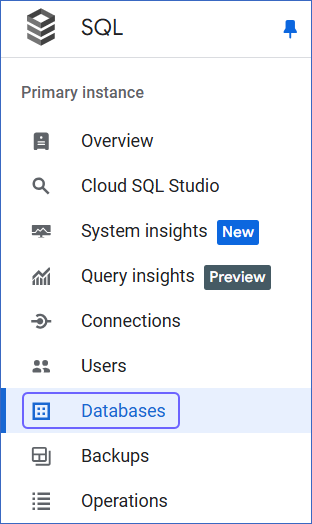
On the Databases page, you can locate the name of your database under the Name column.

Perform the following steps to configure your Google Cloud SQL Server Source:
-
Click PIPELINES in the Navigation Bar.
-
Click + Create Pipeline in the Pipelines List View.
-
On the Select Source Type page, select Google Cloud SQL Server.
-
On the Select Destination Type page, select the type of Destination you want to use.
-
On the page that appears, do the following:
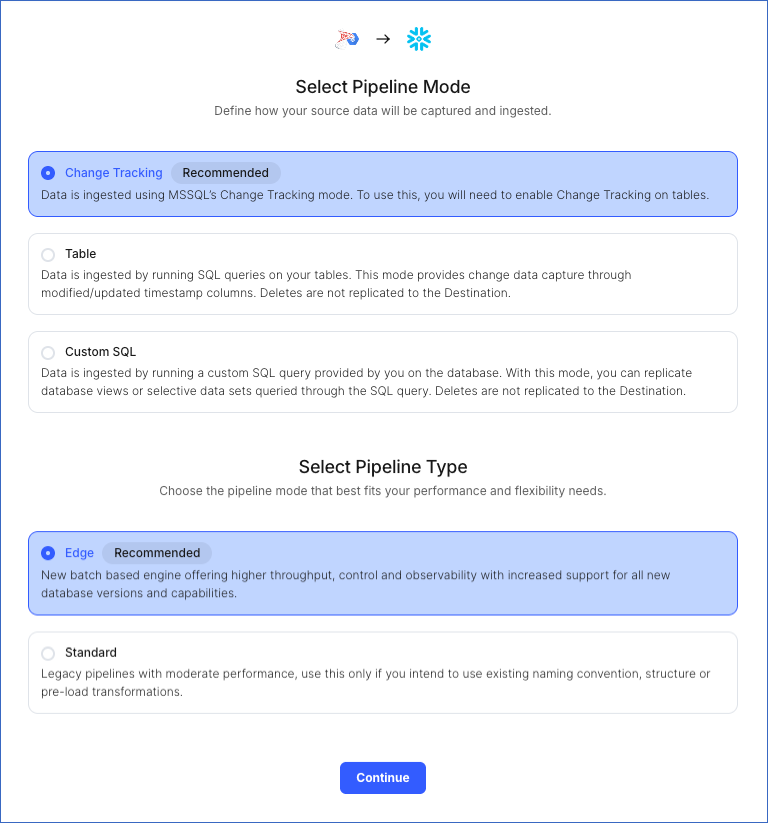
-
Select Pipeline Mode: Choose Change Tracking. Hevo supports only this mode for Edge Pipelines created with SQL Server Source. If you choose any other mode, you can proceed to create a Standard Pipeline.
-
Select Pipeline Type: Choose the type of Pipeline you want to create based on your requirements, and then click Continue.
-
If you select Edge, skip to step 6 below.
-
If you select Standard, read Google Cloud SQL Server to configure your Standard Pipeline.
This section is displayed only if all the following conditions are met:
-
The selected Destination type is supported in Edge.
-
The Pipeline mode is set to Change Tracking.
-
Your Team was created before September 15, 2025, and has an existing Pipeline created with the same Destination type and Pipeline mode.
For Teams that do not meet the above criteria, if the selected Destination type is supported in Edge and the Pipeline mode is set to Change Tracking, you can proceed to create an Edge Pipeline. Otherwise, you can proceed to create a Standard Pipeline. Read Google Cloud SQL Server to configure your Standard Pipeline.
-
In the Configure Source screen, specify the following:
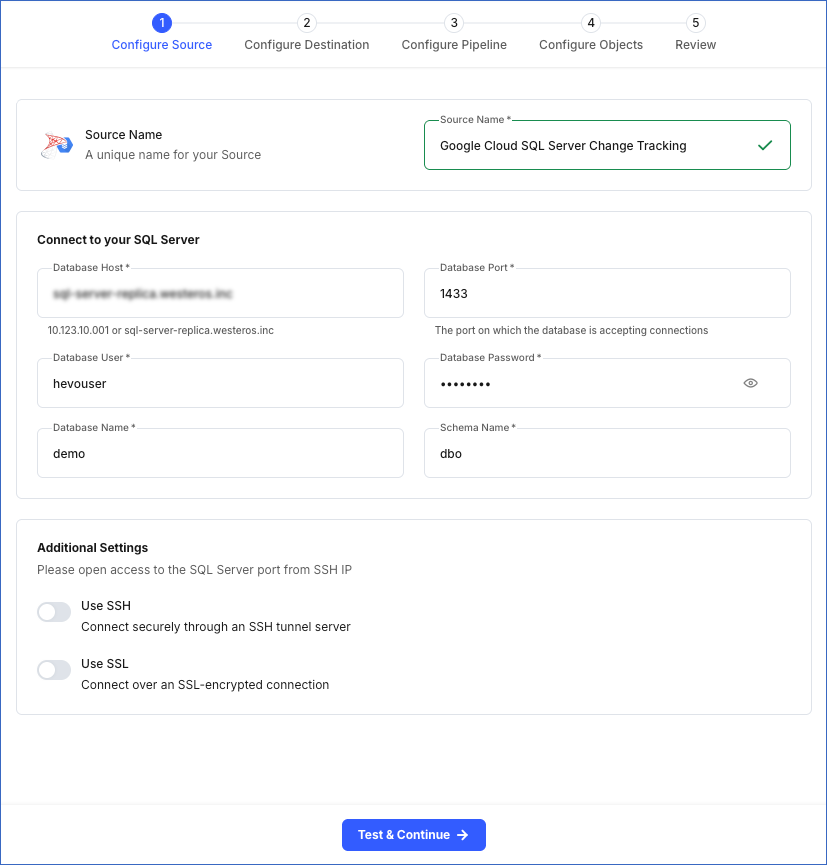
-
Source Name: A unique name for your Source, not exceeding 255 characters. For example, Google Cloud SQL Server Change Tracking.
-
In the Connect to your SQL Server section:
-
Database Host: The Google Cloud SQL Server host’s IP address or DNS. This is the Public IP address that you obtained in the Retrieve the database hostname step of the Getting Started section.
-
Database Port: The port on which your Google Cloud SQL Server listens for connections. Default value: 1433.
-
Database User: The authenticated user who has the permissions to read tables in your database. This user can be the login user created in the Create a database user (Optional) step of the Getting Started section. For example, hevouser.
-
Database Password: The password for your database user.
-
Database Name: The database from where you want to replicate data. For example, demo.
-
Schema Name: The schema that holds the tables to be replicated. Default value: dbo.
-
In the Additional Settings section:
-
Use SSH: Enable this option to connect to Hevo using an SSH tunnel instead of directly connecting your Google Cloud SQL Server database host to Hevo. This provides an additional level of security to your database by not exposing your Google Cloud SQL Server setup to the public.
If this option is turned off, you must configure your Source to accept connections from Hevo’s IP address.
-
Use SSL: Enable this option to use an SSL-encrypted connection. Specify the following:
-
CA File: The file containing the SSL server certificate authority (CA).
-
Client Certificate: The client’s public key certificate file.
-
Client Key: The client’s private key file.
-
Click Test & Continue to test the connection to your Google Cloud SQL Server Source. Once the test is successful, you can proceed to set up your Destination.
Read the detailed Hevo documentation for the following related topics:
Data Type Mapping
Hevo maps the SQL Server Source data type internally to a unified data type, referred to as the Hevo Data Type, in the table below. This data type is used to represent the Source data from all supported data types in a lossless manner.
The following table lists the supported SQL Server data types and the corresponding Hevo data type to which they are mapped:
| SQL Server Data Type |
Hevo Data Type |
- CHAR
- VARCHAR
- TEXT
- NCHAR
- NVARCHAR
- NTEXT
- XML
- UNIQUEIDENTIFIER
- GEOMETRY
- GEOGRAPHY
- HIERARCHYID
- SQL_VARIANT |
VARCHAR |
| - DATETIMEOFFSET |
TIMESTAMPTZ |
- DATETIME
- SMALLDATETIME
- DATETIME2 |
TIMESTAMP |
| - TIME |
TIME |
- TINYINT
- SMALLINT |
SHORT |
| - BIGINT |
LONG |
| - INT |
INTEGER |
| - REAL |
FLOAT |
| - FLOAT |
DOUBLE |
- NUMERIC
- DECIMAL
- MONEY
- SMALLMONEY |
DECIMAL |
| - DATE |
DATE |
- BINARY
- VARBINARY
- IMAGE
- TIMESTAMP |
BYTEARRAY |
| - BIT |
BOOLEAN |
At this time, the following SQL Server data types are not supported by Hevo:
Note: If any of the Source objects contain data types that are not supported by Hevo, the corresponding fields are marked as unsupported during object configuration in the Pipeline.
Source Considerations
-
When a record is updated multiple times between two consecutive data ingestion runs, Change Tracking provides only the latest update made to the record. As a result, Hevo ingests only the latest record at the time of ingestion, which can lead to the loss of any updates that occurred between the previous ingestion and the current one.
-
By default, SQL Server uses a case-insensitive collation. This means that values such as tables, Tables, and TABLES are treated as identical by the server.
To differentiate between cases in your data, change the collation to case-sensitive.
Limitations
-
Hevo does not support data replication from temporary tables and views.
-
Hevo does not set the metadata column __hevo__marked_deleted to True for data deleted from the Source table using the TRUNCATE command. This action could result in a data mismatch between the Source and Destination tables.

